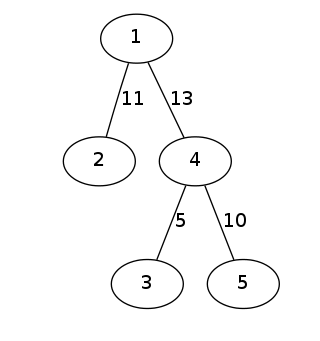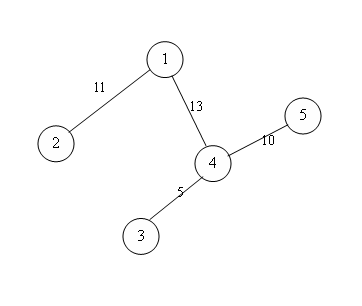POJ 3585 Accumulation Degree
Description
Trees are an important component of the natural landscape because of their prevention of erosion and the provision of a specific ather-sheltered ecosystem in and under their foliage. Trees have also been found to play an important role in producing oxygen and reducing carbon dioxide in the atmosphere, as well as moderating ground temperatures. They are also significant elements in landscaping and agriculture, both for their aesthetic appeal and their orchard crops (such as apples). Wood from trees is a common building material.
Trees also play an intimate role in many of the world's mythologies. Many scholars are interested in finding peculiar properties about trees, such as the center of a tree, tree counting, tree coloring. A(x) is one of such properties.
A(x) (accumulation degree of node x) is defined as follows:
- Each edge of the tree has an positive capacity.
- The nodes with degree of one in the tree are named terminals.
- The flow of each edge can't exceed its capacity.
- A(x) is the maximal flow that node x can flow to other terminal nodes.
Since it may be hard to understand the definition, an example is showed below:
| A(1)=11+5+8=24 | ||
|---|---|---|
| Details: | 1->2 | 11 |
| 1->4->3 | 5 | |
| 1->4->5 | 8(since 1->4 has capacity of 13) | |
| A(2)=5+6=11 | ||
| Details: | 2->1->4->3 | 5 |
| 2->1->4->5 | 6 | |
| A(3)=5 | ||
| Details: | 3->4->5 | 5 |
| A(4)=11+5+10=26 | ||
| Details: | 4->1->2 | 11 |
| 4->3 | 5 | |
| 4->5 | 10 | |
| A(5)=10 | ||
| Details: | 5->4->1->2 | 10 |
The accumulation degree of a tree is the maximal accumulation degree among its nodes. Here your task is to find the accumulation degree of the given trees.
Input
The first line of the input is an integer T which indicates the number of test cases. The first line of each test case is a positive integer n. Each of the following n - 1 lines contains three integers x, y, z separated by spaces, representing there is an edge between node x and node y, and the capacity of the edge is z. Nodes are numbered from 1 to n.
All the elements are nonnegative integers no more than 200000. You may assume that the test data are all tree metrics.
Output
For each test case, output the result on a single line.
Sample Input
1
5
1 2 11
1 4 13
3 4 5
4 5 10
Sample Output
26
题目大意:
有一棵有(n)个节点、(n-1)条边的无根树,每边有一流量限制。令某一节点为根节点,向根节点灌水,最终从叶子节点流出的水量和为这一节点的最大流量。问:在做根节点的所有节点中,最大的最大流量是多少?
题解:
很容易想到这个某个节点的最大流量可以用树形DP来维护,但是因为一次树形DP是(O(n))的复杂度,如果有(n)个点,那么其复杂度就是(O(n^2))的,(nle 2*10^5),还是多组数据,必炸无疑。
那么就不能暴力地在每个节点都跑一次树形DP,即需要一种不需要每次都跑的船新操作。
我们叫他换根DP。我的理解就是,树形DP+换根。
俗称扭一扭,因为在换根的过程中,树的形态发生了扭转。
那么我们考虑,用一次树形DP作为信息的预处理,然后之后的答案能否通过预处理,使用换根DP来维护呢?
PS:先讲树形DP预处理。
一般来讲,树的形态固定的情况下,才可以把边权转点权(把边权值给儿子,比如树链剖分等等,比较常见的操作)。但换根DP因为树的形态会扭,所以不适合把边权转点券。那么我们DP设置的状态就需要以边作维护。
状态设置为:(sum[x])表示以(x)点为根的子树所能提供的最大流量和,那么显然,儿子节点对于父亲的贡献就是这个(sum[x])和父亲到儿子的边权的较小值。比如下图(以1为根),(sum[4]=15),但是(4)号点对答案的贡献其实是13,因为被限制了。
所以转移方程就是:
需要注意的是初值,叶子节点的(sum)值应该为0,所以转移的时候应该从倒数第二层节点开始转,这个处理我们可以通过特判解决。
于是我们处理出了一个以(1)为根的(sum)数组,答案就是(sum[1])。
然后就是扭一扭的过程,先上图。
比如,以1为根的情况和以4为根的情况:(如图)


我们发现,4-3-5这棵子树的信息是没有变化的,只是原先1是4的儿子,现在儿子翻身当爹了而已,也就是,只有以1为根的子树的信息需要重新统计。我们又发现,1有很多儿子,其中只有4当了爹,其他的儿子依然是儿子,所以只需要把1之前与4的关系断掉,进行重新统计。也就是说,原来的(sum[1])要减去(sum[4])和它俩之间的边权的较小值,也就是13。成为新的(sum[1])。
然后在新的根节点4上加上新的(sum[1])即可。
这个扭一扭的过程可以通过第二次深搜来实现。
需要注意的细节是,当我们进行到叶子节点的时候,需要进行特殊判断,很容易得出,在叶子节点和非叶子节点的转移方程是不一样的。
详见代码:
#include<cstdio>
#include<cstring>
#include<algorithm>
using namespace std;
const int maxn=2*1e5+10;
int n;
int tot,to[maxn<<1],nxt[maxn<<1],val[maxn<<1],head[maxn];
int sum[maxn<<1],dp[maxn<<1],du[maxn],ans;
void add(int x,int y,int z)
{
to[++tot]=y;
val[tot]=z;
nxt[tot]=head[x];
head[x]=tot;
}
void dfs1(int x,int f)
{
for(int i=head[x];i;i=nxt[i])
{
int y=to[i];
if(y==f)
continue;
dfs1(y,x);
if(du[y]>1)
sum[x]+=min(val[i],sum[y]);
else
sum[x]+=val[i];
}
}
void dfs2(int x,int f)
{
for(int i=head[x];i;i=nxt[i])
{
int y=to[i];
if(y==f)
continue;
if(du[x]==1)//leaf
dp[y]=sum[y]+val[i];
else
dp[y]=sum[y]+min(dp[x]-min(sum[y],val[i]),val[i]);
dfs2(y,x);
}
}
void clean()
{
tot=0;
ans=-1;
memset(sum,0,sizeof(sum));
memset(du,0,sizeof(du));
memset(dp,0,sizeof(dp));
memset(to,0,sizeof(to));
memset(nxt,0,sizeof(nxt));
memset(head,0,sizeof(head));
memset(val,0,sizeof(val));
}
int main()
{
int t;
scanf("%d",&t);
while(t--)
{
clean();
scanf("%d",&n);
for(int i=1;i<n;i++)
{
int x,y,z;
scanf("%d%d%d",&x,&y,&z);
add(x,y,z);
add(y,x,z);
du[x]++;
du[y]++;
}
dfs1(1,0);
dp[1]=sum[1];
dfs2(1,0);
for(int i=1;i<=n;i++)
ans=max(ans,dp[i]);
printf("%d
",ans);
}
return 0;
}
